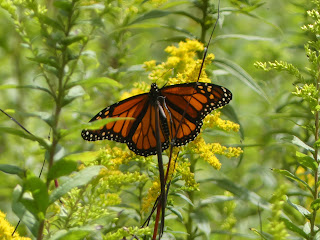A Male Monarch
Over the course of the summer I'll usually spot quite a few Monarch butterflies. I'm sure this is due to a few factors:
- The bright orange coloring and decent size makes them more conspicuous than most other insects.
- Though their populations are trending in a bad direction, they remain one of the more common butterflies around.
- They spend a lot of time around wildflowers, exactly where you'd expect to see them [1].
Monarchs are considered to be a fairly classic example of aposematism, which is attention-getting signal that an organism is dangerous to eat. In the Monarch, the bright orange coloring alerts (many) predators that they're poisonous. (This probably prevents them from getting eaten by most birds, though I've seen mantises eating them.)
 |
| September 8, 2022 at Fairview Farm Photo 248393626, (c) jpviolette, some rights reserved (CC BY-NC) |
[1] Some butterflies aren't big fans of nectar and are rarely found among them. (I'm looking at you, commas. And you, Mourning Cloaks.)



Comments
Post a Comment